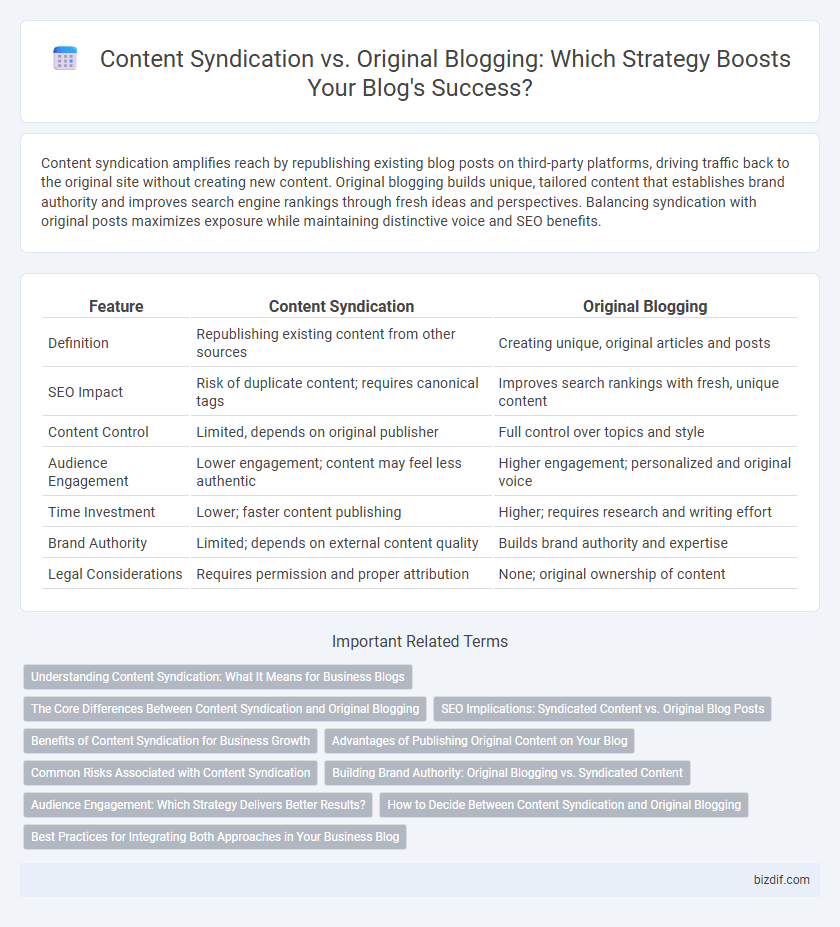Content syndication amplifies reach by republishing existing blog posts on third-party platforms, driving traffic back to the original site without creating new content. Original blogging builds unique, tailored content that establishes brand authority and improves search engine rankings through fresh ideas and perspectives. Balancing syndication with original posts maximizes exposure while maintaining distinctive voice and SEO benefits.
Table of Comparison
| Feature | Content Syndication | Original Blogging |
|---|---|---|
| Definition | Republishing existing content from other sources | Creating unique, original articles and posts |
| SEO Impact | Risk of duplicate content; requires canonical tags | Improves search rankings with fresh, unique content |
| Content Control | Limited, depends on original publisher | Full control over topics and style |
| Audience Engagement | Lower engagement; content may feel less authentic | Higher engagement; personalized and original voice |
| Time Investment | Lower; faster content publishing | Higher; requires research and writing effort |
| Brand Authority | Limited; depends on external content quality | Builds brand authority and expertise |
| Legal Considerations | Requires permission and proper attribution | None; original ownership of content |
Understanding Content Syndication: What It Means for Business Blogs
Content syndication involves republishing your existing blog content on third-party platforms to reach a broader audience and drive traffic back to your site. Unlike original blogging, which focuses on creating unique and exclusive content, syndication leverages established networks to increase visibility and enhance brand authority. Effective content syndication can improve SEO through backlinks and domain authority, making it a strategic tool for business blogs aiming to scale their online presence.
The Core Differences Between Content Syndication and Original Blogging
Content syndication involves republishing existing articles across multiple platforms to increase reach and drive traffic, while original blogging creates unique, fresh content tailored to a specific audience or brand voice. The core differences lie in content ownership, SEO impact, and audience engagement; original blogs boost search engine rankings through exclusive content, whereas syndicated content can risk duplicate content penalties if not managed properly. Effective content strategies balance both by leveraging original posts for authority and syndication for wider distribution.
SEO Implications: Syndicated Content vs. Original Blog Posts
Original blog posts boost SEO by providing unique content that search engines prioritize, improving domain authority and organic rankings. Content syndication can increase reach and drive traffic but risks duplicate content penalties if not properly managed with canonical tags or noindex directives. Strategically balancing syndicated content and original posts enhances visibility while maintaining SEO integrity.
Benefits of Content Syndication for Business Growth
Content syndication amplifies brand visibility by distributing original articles across multiple high-traffic websites, increasing reach without the need for constant new content creation. This strategy drives consistent referral traffic and enhances search engine rankings through diversified backlinks. Businesses benefit from cost-effective exposure and accelerated audience growth, leveraging established platforms to boost authority and lead generation.
Advantages of Publishing Original Content on Your Blog
Publishing original content on your blog enhances search engine optimization by offering unique, keyword-rich material that attracts and retains readers. It establishes your expertise and builds trust with your audience, fostering stronger engagement and brand loyalty. Original blogging also increases the likelihood of social shares and backlinks, driving organic traffic and improving domain authority.
Common Risks Associated with Content Syndication
Content syndication carries risks such as duplicate content penalties from search engines, which can negatively impact SEO rankings for original bloggers. It may also dilute brand authority when syndicated content appears on lower-quality or irrelevant websites. Furthermore, reliance on syndicated distribution can reduce traffic to the original blog, limiting direct audience engagement and growth opportunities.
Building Brand Authority: Original Blogging vs. Syndicated Content
Original blogging enhances brand authority by showcasing unique insights and expertise, fostering trust and loyalty among readers. Syndicated content can expand reach but often lacks the distinct voice and credibility that original posts provide. Consistent creation of original content strengthens search engine rankings and positions the brand as an industry leader.
Audience Engagement: Which Strategy Delivers Better Results?
Original blogging generates higher audience engagement by offering unique, authentic content that builds trust and encourages interaction through comments and shares. Content syndication expands reach by distributing existing posts across multiple platforms, increasing visibility but often resulting in diluted engagement rates. For sustained audience growth, original blogging delivers better results by fostering a loyal community and enhancing SEO performance.
How to Decide Between Content Syndication and Original Blogging
Choosing between content syndication and original blogging depends on your goals for audience reach and SEO impact. Original blogging enhances brand authority and improves search engine rankings through unique, tailored content, while content syndication boosts exposure by distributing existing content on multiple platforms. Evaluate your resources, desired content control, and long-term growth strategy to determine which approach aligns best with your blogging objectives.
Best Practices for Integrating Both Approaches in Your Business Blog
Content syndication and original blogging each offer unique advantages for expanding your business blog's reach and authority. Integrate syndication by repurposing high-performing original posts on reputable platforms to drive traffic back to your site while maintaining fresh, exclusive content to build trust and SEO value. Consistently monitor engagement metrics and use canonical tags to prevent duplicate content issues, ensuring sustainable growth in visibility and audience retention.
Content syndication vs Original blogging Infographic

 bizdif.com
bizdif.com